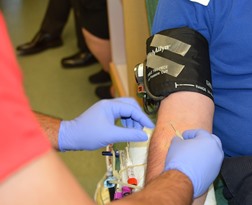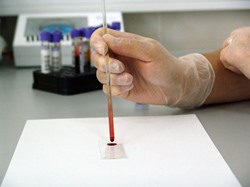Selecting a Phlebotomy Training Program near Axis Alabama
 Selecting the ideal phlebotomy school near Axis AL is an essential initial step toward a gratifying career as a phlebotomist. It may seem like a difficult undertaking to assess and compare each of the training alternatives that are available to you. Nevertheless it’s important that you perform your due diligence to make certain that you obtain a superior education. In fact, many potential students begin their search by considering two of the qualifiers that initially come to mind, which are cost and location. Yet another option you might consider is whether to attend classes online or commute to a nearby campus. We’ll talk more about online schools later in this article. What you need to remember is that there is much more to checking out phlebotomy training programs than locating the cheapest or the closest one. Other factors such as accreditation and reputation are also significant considerations and need to be part of your decision process too. To assist in that effort, we will provide a list of questions that you need to ask each of the phlebotomy schools you are evaluating to help you choose the ideal one for you. But prior to doing that, let’s cover what a phlebotomist is and does, and afterwards continue our discussion about online classes.
Selecting the ideal phlebotomy school near Axis AL is an essential initial step toward a gratifying career as a phlebotomist. It may seem like a difficult undertaking to assess and compare each of the training alternatives that are available to you. Nevertheless it’s important that you perform your due diligence to make certain that you obtain a superior education. In fact, many potential students begin their search by considering two of the qualifiers that initially come to mind, which are cost and location. Yet another option you might consider is whether to attend classes online or commute to a nearby campus. We’ll talk more about online schools later in this article. What you need to remember is that there is much more to checking out phlebotomy training programs than locating the cheapest or the closest one. Other factors such as accreditation and reputation are also significant considerations and need to be part of your decision process too. To assist in that effort, we will provide a list of questions that you need to ask each of the phlebotomy schools you are evaluating to help you choose the ideal one for you. But prior to doing that, let’s cover what a phlebotomist is and does, and afterwards continue our discussion about online classes.
Phlebotomist Work Summary
 A phlebotomist, or phlebotomy tech, draws blood from patients. While that is their primary responsibility, there is actually far more to their job description. Prior to drawing a blood sample, a phlebotomist has to verify that the instruments being used are sterile and single use only. After collection, the sample needs to be correctly labeled with the patient’s information. Next, paperwork has to be correctly completed to be able to track the sample from the time of collection through the laboratory screening process. The phlebotomist then delivers the blood to either an in-house lab or to an outside lab facility where it can be screened for such things as pregnancy, infectious diseases or blood type. Many Axis AL phlebotomists in fact work in labs and are in charge of making certain that samples are analyzed properly under the strictest quality assurance procedures. And if those weren’t sufficient responsibilities, they can be called upon to train other phlebotomists in the drawing, transport and follow-up process.
A phlebotomist, or phlebotomy tech, draws blood from patients. While that is their primary responsibility, there is actually far more to their job description. Prior to drawing a blood sample, a phlebotomist has to verify that the instruments being used are sterile and single use only. After collection, the sample needs to be correctly labeled with the patient’s information. Next, paperwork has to be correctly completed to be able to track the sample from the time of collection through the laboratory screening process. The phlebotomist then delivers the blood to either an in-house lab or to an outside lab facility where it can be screened for such things as pregnancy, infectious diseases or blood type. Many Axis AL phlebotomists in fact work in labs and are in charge of making certain that samples are analyzed properly under the strictest quality assurance procedures. And if those weren’t sufficient responsibilities, they can be called upon to train other phlebotomists in the drawing, transport and follow-up process.
Where are Phlebotomists Employed?
The quickest response is wherever patients are treated. Their workplaces are many and diverse, including Axis AL hospitals, medical clinics, long-term care facilities, or blood banks. They can be assigned to draw blood samples from patients of of every age, from infants or young children to seniors. A number of phlebotomists, depending on their training and their practice, specialize in drawing samples from a particular type of patient. For instance, those working in an assisted living facility or nursing home would solely be collecting blood from elderly patients. If they are working in a maternity ward, they would be collecting blood from newborns and mothers exclusively. In contrast, phlebotomists practicing in a general hospital setting would be drawing samples from a wide variety of patients and would work with different patients on a daily basis.
Phlebotomy Technician Education, Licensing and Certification
 There are essentially two types of programs that furnish phlebotomist training in Axis AL, which are certificate and degree programs. The certificate program usually takes under a year to finish and provides a basic education as well as the training on how to draw blood. It offers the quickest means to becoming a phlebotomist. An Associate of Science Degree in Clinical Laboratory Science, even though it’s not exclusively a phlebotomy degree, will incorporate training on becoming a phlebotomist. Offered at junior and community colleges, they normally take two years to complete. Bachelor’s Degrees are not as accessible and as a 4 year program provide a more expansive foundation in lab sciences. After you have completed your training, you will no doubt want to get certified. While not mandated in most states, many employers look for certification before employing technicians. A few of the main certifying agencies include:
There are essentially two types of programs that furnish phlebotomist training in Axis AL, which are certificate and degree programs. The certificate program usually takes under a year to finish and provides a basic education as well as the training on how to draw blood. It offers the quickest means to becoming a phlebotomist. An Associate of Science Degree in Clinical Laboratory Science, even though it’s not exclusively a phlebotomy degree, will incorporate training on becoming a phlebotomist. Offered at junior and community colleges, they normally take two years to complete. Bachelor’s Degrees are not as accessible and as a 4 year program provide a more expansive foundation in lab sciences. After you have completed your training, you will no doubt want to get certified. While not mandated in most states, many employers look for certification before employing technicians. A few of the main certifying agencies include:
- National Phlebotomy Association
- National Healthcareer Association (NHA)
- American Society for Clinical Pathology (ASCP)
- American Medical Technologists (AMT)
There are several states that do require certification in order to practice as a phlebotomist, like Nevada and California. California and a few additional states even require licensing. So it’s imperative that you pick a phlebotomist training program that not only furnishes a quality education, but also preps you for any certification or licensing exams that you elect or are required to take.
Online Phlebotomy Training
 First, let’s resolve one likely misconception. You can’t get all of your phlebotomist training online. A significant component of the curriculum will be practical training and it will be carried out either in an approved Axis AL healthcare facility or an on-campus lab|an on-campus lab or an approved healthcare facility}. A large number of courses also require completion of an internship in order to graduate. But since the non-clinical component of the training can be accessed online, it may be a more convenient option for many students. As an additional benefit, a number of online colleges are more affordable than their on-campus counterparts. And some expenditures, for instance those for commuting or textbooks, may be lessened as well. Just make sure that the online phlebotomy school you select is accredited by a regional or national accrediting agency (more on accreditation to follow). With both the extensive online and clinical training, you can receive a quality education with this method of learning. If you are disciplined enough to study at home, then attaining your degree or certificate online might be the right choice for you.
First, let’s resolve one likely misconception. You can’t get all of your phlebotomist training online. A significant component of the curriculum will be practical training and it will be carried out either in an approved Axis AL healthcare facility or an on-campus lab|an on-campus lab or an approved healthcare facility}. A large number of courses also require completion of an internship in order to graduate. But since the non-clinical component of the training can be accessed online, it may be a more convenient option for many students. As an additional benefit, a number of online colleges are more affordable than their on-campus counterparts. And some expenditures, for instance those for commuting or textbooks, may be lessened as well. Just make sure that the online phlebotomy school you select is accredited by a regional or national accrediting agency (more on accreditation to follow). With both the extensive online and clinical training, you can receive a quality education with this method of learning. If you are disciplined enough to study at home, then attaining your degree or certificate online might be the right choice for you.
Points to Ask Phlebotomy Colleges
Since you now have a basic idea about what it takes to become a phlebotomist, it’s time to begin your due diligence process. You might have already decided on the kind of program you want to enroll in, whether it be for a certificate or a degree. As we mentioned earlier, the location of the Alabama campus is relevant in addition to the cost of tuition. Perhaps you have decided to enroll in an online phlebotomy program. All of these decisions are a critical component of the process for selecting a program or school. But they are not the sole concerns when arriving at your decision. Below we have provided several questions that you should ask about each of the Axis AL programs you are considering prior to making your final decision.
Is the Phlebotomy Program Specific to Alabama? As mentioned previously, each state has its own laws for practicing as a phlebotomist. Some states require certification, while some others require licensing. Every state has its own prerequisite regarding the minimum hours of practical training performed before working as a phlebotomy tech. As a result, you might need to pass a State Board, licensing or certification examination. Therefore it’s extremely important to choose a phlebotomy program that satisfies the state specific requirements for Alabama or the state where you will be practicing and readies you for any exams you may have to take.
Is the College Accredited? The phlebotomist program and school you select should be accredited by a highly regarded regional or national accrediting agency, such as the National Accrediting Agency for Clinical Laboratory Sciences (NAACLS). There are a number of advantages to graduating from an accredited school in addition to a guarantee of a superior education. First, if your program is not accredited, you will not qualify to take a certification examination offered by any of the earlier listed certifying agencies. Also, accreditation will help in securing loans or financial assistance, which are frequently unavailable for non-accredited schools in Axis AL. Last, graduating from an accredited college can make you more attractive to future employers in the job market.
What is the College’s Ranking? In numerous states there is little or no regulation of phlebotomy schools, so there are those that are not of the highest quality. So along with accreditation, it’s essential to investigate the reputations of any colleges you are considering. You can begin by asking the schools for references from employers where they place their graduates as part of their job assistance program. You can screen internet school rating and review services and ask the accrediting organizations for their reviews as well. You can even contact a few Axis AL area hospitals or clinics that you might have an interest in working for and see if they can offer any insights. As a final thought, you can contact the Alabama school licensing authority and find out if any complaints have been submitted or if the schools are in total compliance.
Is Enough Training Included? To begin with, check with the Alabama regulator or the state regulator where you will be working to find out if there are any minimum requirements for the amount of training, both clinical and classroom. As a minimum, any Axis AL phlebotomy program that you are considering should furnish no less than 40 hours of classroom training (the majority require 120) and 120 hours of practical training. Anything less than these minimums may signify that the program is not expansive enough to offer adequate training.
Are Internships Included? Ask the Alabama programs you are considering if they have an internship program in collaboration with regional healthcare facilities. They are the optimal way to obtain hands-on practical training frequently not provided on campus. As an added benefit, internships can help students develop relationships within the local Axis AL healthcare community. And they look good on resumes as well.
Is Job Placement Support Provided? Getting your first phlebotomist job will be a lot easier with the assistance of a job placement program. Find out if the schools you are reviewing provide assistance and what their job placement rate is. If a school has a higher rate, signifying they place the majority of their students in jobs, it’s an indication that the college has both a good reputation along with an extensive network of professional contacts within the Axis AL health care community.
Are Class Times Offered to Fit Your Schedule? Finally, it’s important to verify that the ultimate program you pick provides classes at times that are compatible with your hectic lifestyle. This is especially important if you decide to continue working while attending college. If you can only go to classes at night or on weekends near Axis AL, make sure they are offered at those times. Additionally, if you can only attend on a part-time basis, confirm it is an option as well. And if you have decided to attend online, with the clinical training requirement, make sure those hours can also be fulfilled within your schedule. And find out what the make-up protocol is should you have to miss any classes because of emergencies or illness.
Why Did You Want to Be a Phlebotomy Tech?
When getting ready to interview for a Phlebotomy Tech job, it's helpful to consider questions you could be asked. One of the things that hiring managers often ask Phlebotomist applicants is "What compelled you to pick Phlebotomy as a profession?". What the interviewer is hoping to uncover is not merely the private reasons you might have for being Phlebotomy Tech, but also what characteristics and talents you possess that make you good at what you do. You will undoubtedly be asked questions relating specifically to Phlebotomy, as well as a certain number of typical interview questions, so you should ready a number of ideas about how you want to answer them. Given that there are so many variables that go into choosing a career, you can address this primary question in a variety of ways. When preparing an answer, attempt to include the reasons the work appeals to you along with the talents you have that make you an exceptional Phlebotomist and the perfiect choice for the position. Don't try to memorize a response, but write down some ideas and anecdotes that pertain to your own experiences and strengths. Reading through sample responses can help you to formulate your own concepts, and inspire ideas of what to include to impress the interviewer.Enroll in the Right Phlebotomist College near Axis AL
Making sure that you pick the ideal phlebotomy training is a critical first step toward your success in this fulfilling medical care field. As we have covered in this article, there are a number of factors that contribute toward the selection of a superior program. Phlebotomy training programs are offered in a number of academic institutes, such as community or junior colleges, trade schools, and colleges and universities that provide an extensive range of programs in healthcare and medical sciences. Program options may vary somewhat across the country as each state has its own prerequisites when it comes to phlebotomy training, certification and licensing. The most important point is that you need to carefully screen and compare each college prior to making your ultimate decision. By addressing the questions that we have furnished, you will be able to fine tune your options so that you can pick the best school for you. And with the appropriate training, you can achieve your goal of becoming a phlebotomy technician in Axis AL.
Learn About Axis Alabama
Axis powers
The Axis powers (German: Achsenmächte, Italian: Potenze dell'Asse, Japanese: 枢軸国 Sūjikukoku), also known as the Axis and the Rome–Berlin–Tokyo Axis, were the nations that fought in World War II against the Allied forces. The Axis powers agreed on their opposition to the Allies, but did not completely coordinate their activity.
The Axis grew out of the diplomatic efforts of Germany, Italy, and Japan to secure their own specific expansionist interests in the mid-1930s. The first step was the treaty signed by Germany and Italy in October 1936. Benito Mussolini declared on 1 November that all other European countries would from then on rotate on the Rome–Berlin axis, thus creating the term "Axis".[1][2] The almost simultaneous second step was the signing in November 1936 of the Anti-Comintern Pact, an anti-communist treaty between Germany and Japan. Italy joined the Pact in 1937. The "Rome–Berlin Axis" became a military alliance in 1939 under the so-called "Pact of Steel", with the Tripartite Pact of 1940 leading to the integration of the military aims of Germany, Italy and Japan.
At its zenith during World War II, the Axis presided over territories that occupied large parts of Europe, North Africa, and East Asia. There were no three-way summit meetings and cooperation and coordination was minimal, with a bit more between Germany and Italy. The war ended in 1945 with the defeat of the Axis powers and the dissolution of their alliance. As in the case of the Allies, membership of the Axis was fluid, with some nations switching sides or changing their degree of military involvement over the course of the war.
The term "axis" was first applied to the Italo-German relationship by the Italian prime minister Benito Mussolini in September 1923, when he wrote in the preface to Roberto Suster's Germania Repubblica that "there is no doubt that in this moment the axis of European history passes through Berlin" (non v'ha dubbio che in questo momento l'asse della storia europea passa per Berlino).[3] At the time he was seeking an alliance with the Weimar Republic against Yugoslavia and France in the dispute over the Free State of Fiume.[4]
More Interesting Alabama Cities
Business Results 1 - 5 of 72
Axis AL Blood Labs - BingNews Search results
-
How to Pick a Home Blood Pressure Monitor
What Is a Blood Pressure Monitor and Why Would You Need One? Your blood pressure reading at the doctor’s office only shows your numbers at that moment. A home monitor lets you check it often ...
-
'Mini kidneys' reveal new insights into metabolic defects in polycystic kidney disease
Scientists at Nanyang Technological University, Singapore (NTU Singapore) have successfully grown 'mini kidneys' in the lab ... al, Kidney organoid models reveal cilium-autophagy metabolic axis ...
-
What Is a Bicarbonate Blood Test?
not the blood cells or the platelets that help your blood clot. A lab technician will add acid to the liquid to unlock carbon dioxide from the bicarbonate. The amount of bicarbonate is measured by ...
-
Can CBD Lower Blood Pressure? 5 Options to Try in 2024
These gummies are broad-spectrum, and according to laboratory reports ... Abuhasira R, et al. (2021). Cannabis is associated with blood pressure reduction in older adults – A 24-hours ambulatory ...
-
Used Jeep SUVs for sale near Axis, AL
*Estimated payments are for informational purposes only. These estimates do not include tax, title, registration fees, lien fees, or any other fees that may be imposed by a governmental agency in ...
-
Used Volkswagen cars for sale near Axis, AL
*Estimated payments are for informational purposes only. These estimates do not include tax, title, registration fees, lien fees, or any other fees that may be imposed by a governmental agency in ...
-
How Does Eating Affect Your Blood Sugar?
Blood sugar, also known as blood glucose, comes from the food you eat. Your body digests some of the food you eat into sugar that then circulates in your bloodstream. Share on Pinterest Jeremy ...
-
AXIS Nova (XPS) Surface Analysis Spectrometer
The AXIS Nova combines XPS imaging and spectroscopic ... resolution as demonstrated by a FWHM
-
Axis Bank Launches Innovation Lab To Accelerate FinTech Startups
Private sector bank, Axis Bank, has launched ‘Thought Factory‘ an innovation lab facility to accelerate innovative technology solutions for the banking sector. The innovation hub located in an ...
-
Japanese Lab Builds 5-Axis 3D Printer
A Japanese lab is investing some time in the possibilities of a 5-axis 3D printer. They show it printing using five axis as well as doing finish machining on a printed part. We’ve covered parts ...
-
When to worry about blood test results
Under a new federal directive, commercial labs are required to give patients ... I asked him whether the technician had a difficult time drawing blood. He replied that indeed she had, leaving ...



